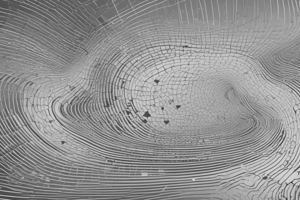Podcast
Questions and Answers
What is a characteristic of a scalar quantity?
What is a characteristic of a scalar quantity?
- It can be represented graphically using arrows
- It can be subtracted by adding the negative of one scalar to another
- It has both magnitude and direction
- It has only magnitude but no direction (correct)
Which of the following is an example of a vector?
Which of the following is an example of a vector?
- Speed
- Displacement (correct)
- Energy
- Mass
How can vectors be added?
How can vectors be added?
- By combining their magnitudes
- By combining their corresponding components (correct)
- By multiplying their magnitudes
- By subtracting their corresponding components
What is the result of multiplying a vector by a number?
What is the result of multiplying a vector by a number?
What notation is used to represent the magnitude of a vector?
What notation is used to represent the magnitude of a vector?
What is a property of vector addition?
What is a property of vector addition?
Flashcards are hidden until you start studying
Study Notes
Scalars and Vectors
Scalars
- A scalar is a quantity with only magnitude (amount or size) but no direction.
- Examples: temperature, mass, time, energy, speed
- Scalars can be added or subtracted by simple arithmetic operations.
- Scalars can be multiplied or divided by numbers.
Vectors
- A vector is a quantity with both magnitude (amount or size) and direction.
- Examples: displacement, velocity, acceleration, force, momentum
- Vectors can be represented graphically using arrows in a coordinate system.
- Vectors have both magnitude (length of the arrow) and direction (direction of the arrow).
Vector Operations
- Addition: Vectors can be added by combining their corresponding components.
- Scalar Multiplication: A vector can be multiplied by a number, which changes its magnitude but not its direction.
- Vector Subtraction: Vectors can be subtracted by adding the negative of one vector to another.
Vector Notation
- Column Notation: Vectors can be represented as columns of numbers, e.g.
|a| |b| - Magnitude: The magnitude of a vector can be represented using the symbol
| |or||, e.g.|a| - Unit Vectors: Vectors with a magnitude of 1, used to represent direction, e.g.
i,j,k
Vector Properties
- Commutative Property: The order of vectors does not change the result of addition, e.g.
a + b = b + a - Associative Property: The order in which vectors are added does not change the result, e.g.
(a + b) + c = a + (b + c) - Distributive Property: A scalar can be distributed to each component of a vector, e.g.
a(b + c) = ab + ac
Studying That Suits You
Use AI to generate personalized quizzes and flashcards to suit your learning preferences.




